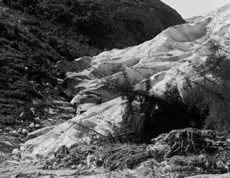Cryosphere glossary
the deposition (sublimation) of ice crystals on a surface which occurs when the temperature of the surface is colder than the air above and colder than the frost point of that air.
a meteorological observation made on the earth's surface, in contrast with an upper-air observation.
the ambient temperature indicated by a thermometer exposed to the air but sheltered from direct solar radiation, or placed in an instrument shelter 1.5 - 2.0 meters (5.0 - 6.6 feet) above ground; also called air temperature.
the cumulative number of degree-days above 0°C for the surface temperature (of the ground, pavement, etc.) during a given period.
wind blowing near the earth's surface; it is measured, by convention, at a height of 10 meters (33 feet) above ground in an area where the distance between the anemometer and any obstruction is at least 10 times the height of the obstruction.
a glacier that experiences a dramatic increase in flow rate, 10 to 100 times faster than its normal rate; usually surge events last less than one year and occur periodically, between 15 and 100 years.
Image

In 1941, Hole-in-the-Wall Glacier surged, also knocking over trees during its advance.
World Data Center for Glaciology, Boulder, CO
a distinct soil micromorphology, resulting from the effects of freezing and thawing processes, in which coarser soil particles have vertical or near-vertical orientation.
permafrost that formed through a rise of the permafrost table during the deposition of additional sediment or other earth material on the ground surface.
the study of the synoptic observation data plotted on synoptic charts aimed at analysis of the atmospheric disturbances (for example, fronts, cyclones, and anticyclones).
a weather chart reflecting the state of the atmosphere over a large area at a given moment.
a code approved by the World Meteorological Organization, by which meteorological elements observed at the earth's surface at synoptic times are encoded in groups of five figures and transmitted internationally through the GTS (Global Telecommunications System).
hour (UTC - Coordinated Universal Time) determined by international agreement at which meteorological observations are made simultaneously throughout the world; the primary synoptic hours are every six hours, commencing at 00:00 UTC.
the study and analysis of synoptic weather information (synoptic charts, synoptic weather observations); thus, it is a study of macro-scale atmospheric processes, as well as weather prediction based on results of synoptic studies.
an observation made at periodic times (usually at 3-hour and 6-hour intervals specified by the World Meteorological Organization) of sky cover, state of the sky, cloud height, atmospheric pressure at sea level, temperature, dew point, wind speed and direction, amount of precipitation, hydrometeors and lithometeors, and special phenomena that prevail at the time of the observation or observed since the previous specified observation.
the scale of the high- and low-pressure systems of the lower atmosphere; dimensions typically range from 1000 to 2500 kilometers (620 to 1550 miles; synoptic-scale circulation).
a flat-topped iceberg that shows horizontal banding; typically form by breaking from an ice shelf.
the open northern part of the boreal forest; consists of open woodland of coniferous trees growing in a rich floor of lichen (mainly reindeer moss or caribou moss), and is generally cold and swampy; lies immediately south of the tundra; in spring, it is often flooded by water from northward flowing rivers, the lower reaches of which are still frozen.